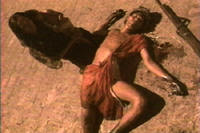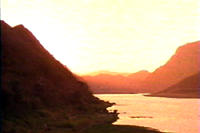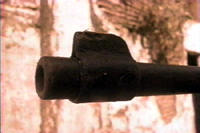

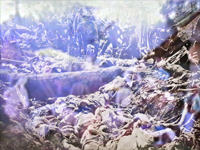 Memories of a Forgotten War will screen at the International Asian-American Film Festival, Sunday, July 21, 3:30pm (program 13), Rose Hall, Asia Society and Museum, New York City.
|
Memories of a Forgotten War:
By John Eperjesi
|
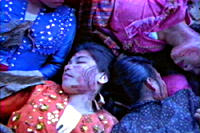
|
In beginning to explore her identity as Filipina-American, Camilla realized that there wasn't a cozy balance between the two sides of the equation. "That's when the light bulb went off," Camilla recalls after reading Twain, "I had finally found a context for the history of domination and abandonment in my family. From that point on, I knew I had to make this film. And I knew I had to go back to the Philippines."
The story Camilla wanted to tell begins with her grandmother, Gregoria Benolirao, who was a seamstress in Manila. In 1916, Gregoria married a U.S. cavalryman, Ralph Dixson, who was in the Philippines as part of the occupation. Their relationship was marked by verbal and emotional abuse, until he eventually abandoned his wife and four children and returned to the U.S., never to be heard from again.
Camilla says that she had two goals in making the film, "To correct the historical record and to create a healing story - healing from the history of violence, both in my family and in the Philippines."
Mainstream history books have perpetuated violence against the Philippines by remembering the war as a "Spanish-American War," a name that brutally misrepresents what really went down, because fighting between a fading world power on one side, and a rising one on the other, was very short-lived, and because the U.S. ended up purchasing the Philippines from Spain for twenty million dollars. So a more accurate name would be the Spanish-American Exchange. The real war began when a loose federation of revolutionary groups in the Philippines seeking independence clashed with occupation forces, and President McKinley, after consulting God, decided to ignore their various declarations of independence, and rule the islands with the end of a bayonet. While "benevolent assimilation" and "civilizing mission" were the upbeat jingles advertising the war to the American public back home, water-torture - which involved bending a captive's head over a rock, forcing their jaw open with the butt of a rifle, and pouring water into their mouth until they reached the edge of drowning - was a popular way of winning consent to American rule. So was burning rice fields. And when Filipinos still refused to give up, American soldiers were ordered to "kill every thing over ten." While the official end of the war was 1902, active resistance to U.S. invasion continued until 1913, hence the temptation to find analogies with the war in Vietnam (or any of America's "interventions" during the Cold War). And as shown in Dogeaters' autopsy of the raunchy underbelly of the Philippines during the Marcos era, fighting never really stopped, as Hollywood has efficiently taken over where the U.S. military left off.
Camilla's training in cultural studies had taught her that she could not tell this story by herselfm "I would be repeating the history of colonial violence and misrepresentation if the Philippines were subjected to yet once again to one voice, one narrative, one goal." There had to be multiple voices and faces and agendas populating the film. As Jean Baudrillard has observed, "For ethnology to live, its object must die." Unlike most documentary filmmakers, who confidently roll into a country, point the camera, and start shooting natives, creating a monologue about other cultures rather than a dialogue, Camilla knew from the start that she needed a Filipina co-director, "I couldn't just go in and write their history for them. It had to be a collaboration because I could tell the story from the American side, but there was still a lot I had to learn. I didn't want my vision to be totalizing."
In 1996, while giving a lecture at the University of the Philippines on representations of war in the media, Camilla asked the chair of the film program if she knew of any women filmmakers that she might work with, and was told that she had to meet Sari. A screening was set up, and Camilla recalls, "When I saw Sari's work, I knew she was the one to shoot the film. It's so hard to represent war, and her work was both experimental and beautiful. I knew that she could represent the dead."
The war did produce a whole lot of dead, most of which, as you can probably guess, were on the Filipino side. While the U.S. suffered 4,200 deaths and 2.800 wounded, estimates at the time claimed that as many as 200,000 Filipinos were killed. But these numbers were more ideological than real, because they included only casualties between 1899-1902, the "official" end of the War. Post-Marcos historians, when finally freed from the grip of an authoritarian government hesitant to upset an important source of its legitimacy, the Bush administration, put the total number of Filipino casualties at over one million.
The media tends to calculate the effects of war in terms of numbers. Memories puts faces to some of those numbers in the form of black and white photographs of both well known revolutionary leaders like Emilio Aguinaldo and Andres Bonifacio, as well as those of ordinary citizens. The U.S. media at the time depicted Filipinos as brutish primitives desperate for a bar of soap and someone to teach them about western civilization. Photographs of some of those killed during war were brought to life by Rocio Martinez, an instructor at Pittsburgh Filmmakers, who digitally colored them with frame grabs from Sari's film footage, revealing the rich Filipino culture that had to be ignored in order to justify the war. The faces that haunt the film are both vivid and fleeting, concrete and ghostly, as they quietly surface and then disappear, wandering restlessly throughout the film.
"Among my earliest childhood memories are old black and white family photographs that were hung in the living room in our old house," Sari remembers. "These photographs haunted me because they have a ghostly quality in group portraits, especially when there are photographic errors like double exposure or overexposure that creates an eerie effect. Most Filipino families are overly superstitious, and believe that the pictures of the dead "breathe" along the years, when it could simply be a photochemical process that gives the black and white photos a fading effect. To most old folks, photographs of the dead are a reminder to the living relatives that their spirits still inhabit the house."
The most haunting of the reenactments was the recreation of the Bud Dajo massacre, during which the U.S. military destroyed an entire Islamic village on the island of Jolo by lobbing artillery into the crater of an extinct volcano where people had been hiding.
Camilla and Sari had a rough idea of what they wanted to do when they started filming, but because accurate information about this war only exists in scattered fragments, they had to make constant revisions of the script. Even within the Philippines, there are conflicting accounts of what really happened. Sari recalls that, "Filming the Bud Dajo Massacre was an ongoing exploration for me. I knew I was recreating an untouched piece of history that has never been seen on celluloid. I went to the library, talked to a lot of historians about the massacre, and I drafted a working script. But when I visited the location where the original violence took place and talked to the descendents and the village historians, I literally ditched my script. It was like unearthing a vast wealth of undocumented stories and details of war."
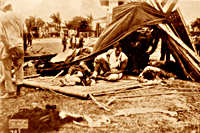
|
The Bud Dajo massacre took place on the island of Jolo. The Islamic people of Jolo are Tausug ("people of the current"), who have fought Spanish, American, and, most recently, Philippine national governmental attempts to control them. In the last thirty years the area has seen considerable strife between the national government and various nationalist groups, including the Moro National Liberation Front (MNLF), the Moro Islamic Liberation Front and the radical Abu Sayaaf movement.
Memories frames a formal wedding ceremony, in which the entire village had come together to celebrate. As bride and groom come together, bombs start dropping. As in the other reenactments, Sari captures the devastating confusion that results when an everyday ritual is suddenly shattered by long range artillery. The origin of the violence is left off screen. As the bodies pile up, the camera voyeuristically surveys the dead, ironically bringing the dead to life in order to haunt the present. Sari comments that, "The camera lingers on their dead bodies because I wanted to show beauty even in the face of death. These women and children are heroes. I wanted the audience to take a long look, to meditate on this fierce tribe who would rather find freedom in death, than be taken alive as prisoners. They died praying and singing."
"Some of the filming, especially on location in Bud Dajo, Jolo, definitely had an otherworldly air," Sari recalls. "For instance, after shooting the mosque sequence where the women and children were killed, a number of the cast began having violent seizures that the Imams attributed to possession by spirits. It took the local shaman the whole night to exorcise the poor actors."
On all levels, Memories breaks with the norms of documentary filmmaking. While standard documentaries strive to create an objective distance from the events and people they describe, Camilla comments that, "We wanted to shatter the safe, objective distance that you get with traditional documentary. We wanted to put the audience in the war zone and let them have an emotional response to it. To be objective about war, not to have an emotional response, is the kind of thinking that allows you to pull the trigger."
"With the Bud Dajo massacre," Sari notes, "I took a very subjective approach, one which was from the perspective of the local Moros who were hopelessly outgunned, but stood their ground in protecting their land. We didn't have the means to recreate a grand battle sequence. So instead of going for a macrocosmic view of the events, we went for the smaller emotional moments of individual people."
Camilla could not go along with the crew when they were filming the Bud Dajo massacre because the island was not politically stable at the time due to the Philippine government's hunting for members of the Abu Sayaff. Reflecting on the reenactment of the Bud Dajo massacre, Sari remembers, "Some people thought I had gone mad when I said I was going to bring my small crew to Jolo, right in the heart of the war zone and to film a "battle scene" complete with explosions, too! Jolo is a small island down south in Mindanao with a long history of warfare, where the media has branded the locals as pirates, kidnappers and Muslim extremists. The Muslim people's place in the history of the Philippines has long been ignored. This film gave them the opportunity to recreate their own history, as told by themselves and played by themselves. This is their gift to the rest of the Philippines and the world, who have never heard of their heroism."
While most of the film is in Tagalog and translated into English, the reenactment of the Bud Dajo massacre is not translated from Tausug into English. While the images paint a pretty clear picture, the lack of translation creates an important fissure that makes it difficult for Western audiences to completely identify with what's going on. In these scenes, the audience is partially pushed away from the film, drawing attention to the invasive nature of all documentaries, no matter how experimental, and showing that, while the community may have been destroyed, the spirit of independence and resistance lives on. When asked why these scenes were left untranslated, Camilla responds, "We wanted this part of the film to be just for the people of Jolo, because they've had so much taken away from them."
While Sari and Camilla worked to create images that would have a healing effect on audiences as well as on themselves, the actual shooting of the film had a powerful effect on the communities where the reenactments were filmed. The people living in these communities were the descendents of those killed during the war. "The whole village would turn up for the shoots," Camilla recalls. "People were sharing oral histories, what they knew and didn't know. They saw themselves as actively making this history. It was a great experience to integrate with the community and tribal groups." And Sari comments, "It is like the process of doing an anthropological project, you live with them, eat and spend long hours listening to their stories. But we were not doing an anthropological film. The collaboration between the crew and the community was born out of mutual curiosity and longing to break religious- cultural barriers that our history has built between us. There was a lot of ignorance between the two parties that contributed to the difficulty of filming the scenes."
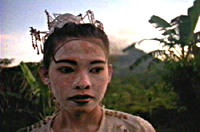
|
"The reenactments in the film create a space to release the rage and paralysis and sorrow of the past, and to feel one's freedom in the present to choose another history," Camilla summarizes. "In having local peoples reenact scenes from their own histories, we not only recreated the reality of war trauma, we also created a way for the participants and the audiences to heal themselves from a violent history."
Screenings of the film have provoked intense responses, especially in the Philippines, where it was first screened this past January. Filipinos wept and applauded, thanking Camilla and Sari for making the film. The dialogues created in the film, within Camilla's family, between Asian-American and Filipina women, between Islamic and Christian communities, between institutional historians and local/oral histories, between the film crew and local people, and between the film and various audiences, not to mention between the Philippines and the United States, has proven that this war has not, and will not be, forgotten.
